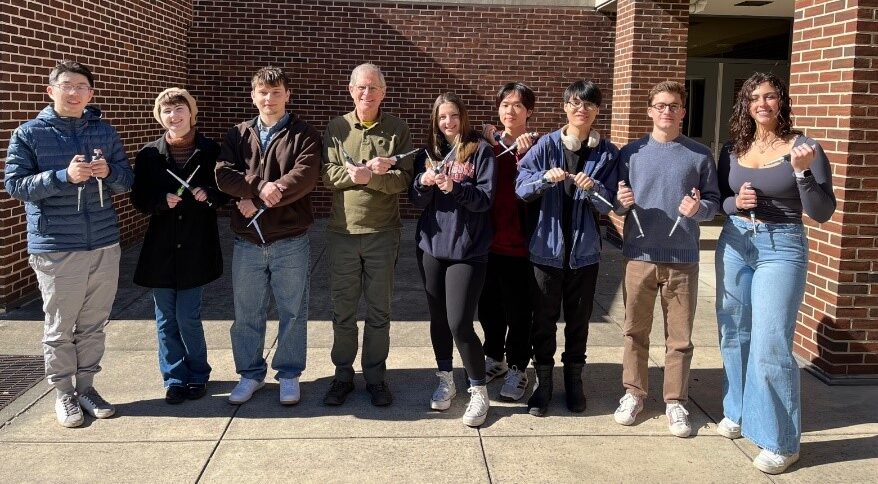Professor Tim Funk, Chemistry
Tim Funk and his students continued to focus on two main projects: the synthesis and catalytic applications of (cyclopentadienone)iron carbonyl compounds, and the development of a library of triazine-based lipids for use in vaccine development and drug delivery—a collaboration with University of Kentucky College of Pharmacy Professor Vince Venditto (’03 Chem).
Work on the latter project was carried out throughout the 2022–2023 academic year by Emily Howe (’23 BMB), Tommy Megna (’23 BMB), and Emily Sullivan (’24 BMB/Spanish). Both Tommy and Emily Howe presented their work at the American Chemical Society Meeting in Indianapolis in March 2023. We temporarily put on hold the synthesis of triazine-based lipids bearing esters—processes developed by Tommy and Emily Sullivan during the summer of 2022—and focused on developing an efficient synthetic approach to lipids with varying ionizable headgroups and hydrophobic tails of different lengths. Tommy’s and Emily Howe’s senior theses described their progress, and Tim and Emily Sullivan learned from their efforts and developed the final route, which they used to prepare a small library of lipids the Venditto group will use in biological studies.
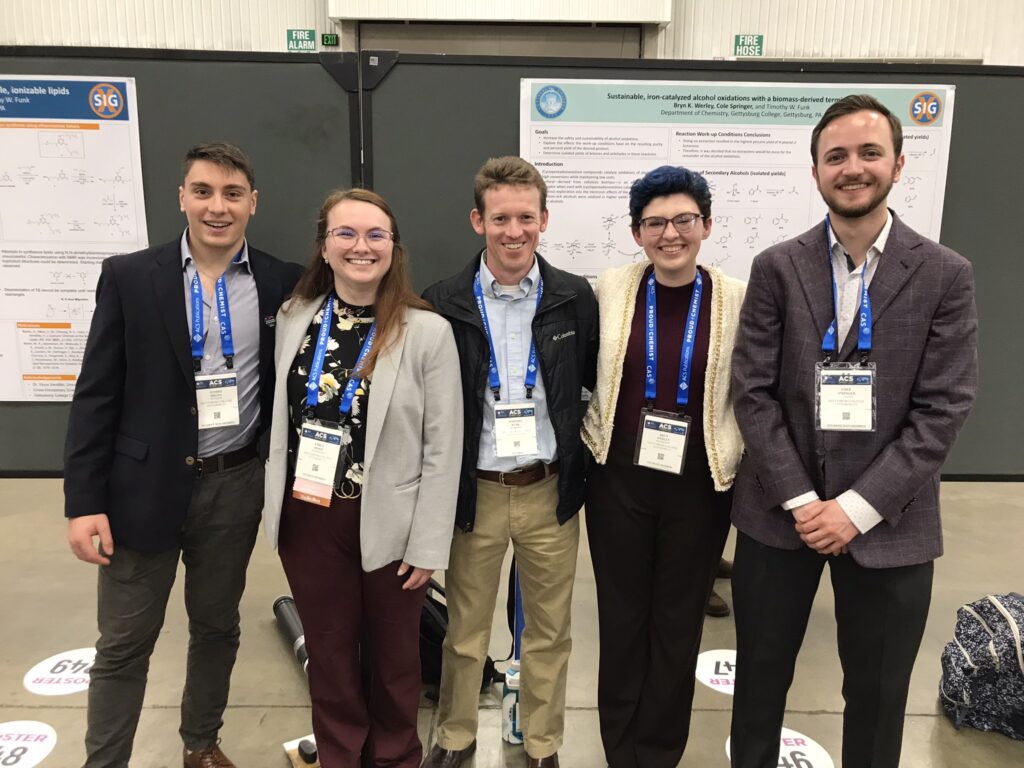
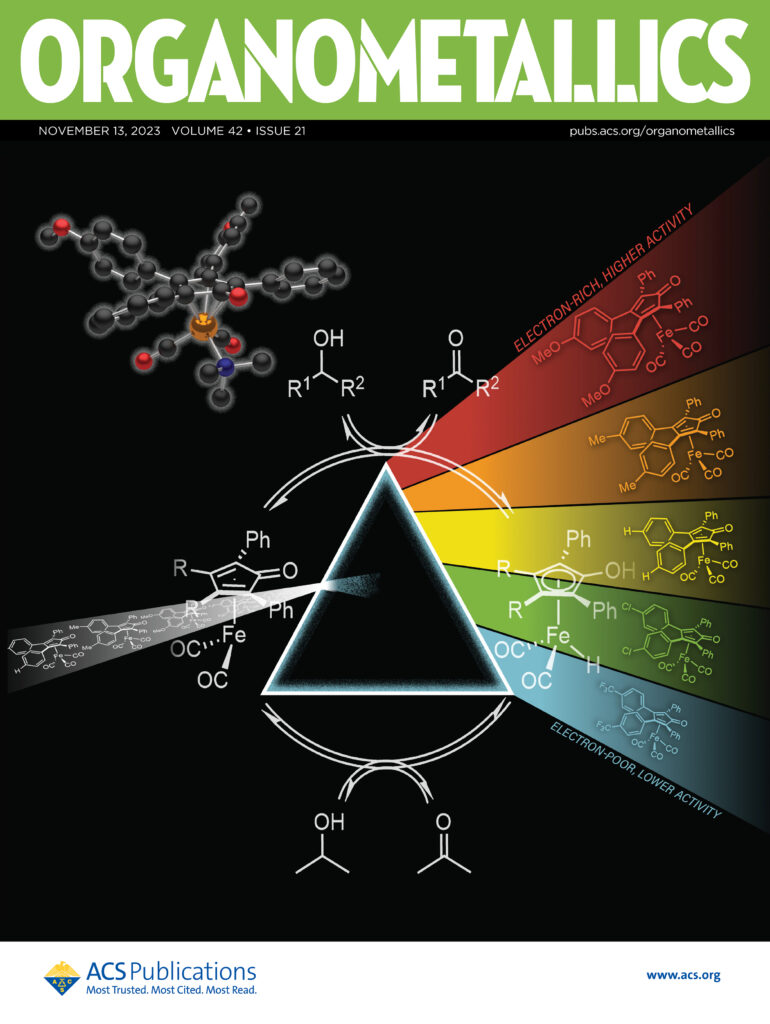
Bryn Werley (’23 Chem/Music) continued her work on the (cyclopentadienone)iron carbonyl catalysis project. Most of her focus during her first-year through her junior year was on mechanistic studies, which, when combined with the results collected by Xintong Amelia Hou (’19 Chem) and Evan Bertonazzi (’20 Chem), resulted in a recent publication in Organometallics . Check out the cover art for that issue of Organometallics—it features our research (and love of classic rock).
Bryn was invited to give an oral presentation at the Gulf Coast Undergraduate Research Symposium at Rice University in October 2022, where she won first prize for it! With that work completed, Bryn turned her attention to oxidizing alcohols using biomass-based furfural as the terminal oxidant. Melanie Hempel (’20 BMB) started this project in 2018, and we are nearing the end of it after Cole Springer (’25 Chem/German Studies) identified and solved our product isolation problems during the summer of 2023. Bryn continued Cole’s work exploring the reaction’s substrate scope and obtaining isolated yields of products. Bryn and Cole co-presented a poster about their work at the American Chemical Society Meeting in Indianapolis in March 2023. Sneha Jayaram (’25 Chem) joined the group in the spring 2023 semester, and she and Cole completed the project during the summer of 2023. Time to write the manuscript! Sneha also started a side project to see if we could use our catalysts to sustainably reduce bisulfite adducts of aldehydes, which are commonly used industrially to isolate unstable aldehydes. She got an exciting lead at the end of the summer which she plans to pursue during the current academic year.
Professor Kate Buettner, Chemistry
The Buettner lab continued their work on developing de novo proteins to function as hydrolases, and the development of mimics of natural haloperoxidase enzymes. Micaylah Bowers (’23 BMB) and Ethan Clare (’25 Chem) continued in the lab, and were joined in January 2023 by Savarna Goutam (’26 Chem and HS). Savarna began to learn the reactivity assay development and characterization that Micaylah had been working. Micaylah and Ethan presented their work at the Spring National ACS meeting in Indianapolis. Over spring break, Prof. Buettner traveled to Korea to visit Prof. Frey and presented the Buettner Lab’s work at SKKU. Late in the semester, Bonnie Coley (’25 Chem) and Sarah Marcus (’26 Chem) joined the lab to take over work on the haloperoxidase enzymes. Micaylah graduated in the spring, and headed to Temple to begin her Ph.D., and the rest of the lab carried on for the summer, moving each of their projects forward in understanding the key structure function relationships in our proteins. In the Fall of 2023, Julia Hunter (’25 BMB) joined the group and got her feet wet with a variety of projects in the lab. This spring, Raphael (Rudy) Rudatsikira (’27 Undeclared) joined the lab to begin some work looking at vanadium binding environments by NMR. Bonnie and Ethan will present their projects at the upcoming National ACS meeting in New Orleans.
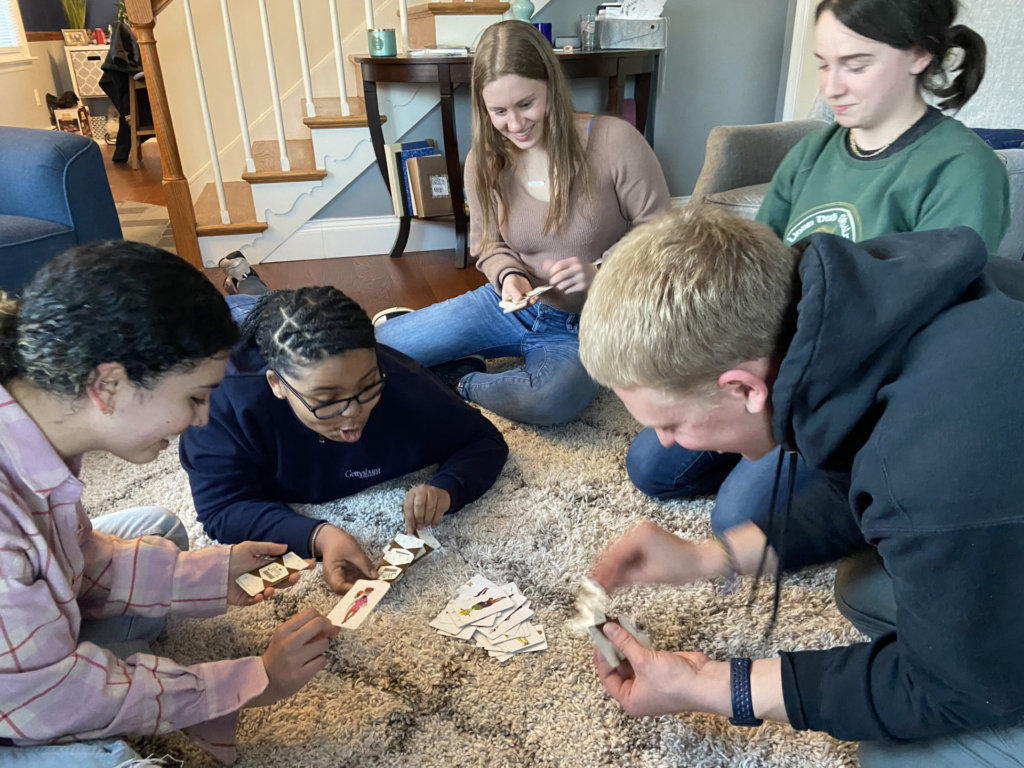
Professor Shelli Frey, Chemistry
In Lipid Lab, Shelli Frey was on a year-long research sabbatical allowing her some unfettered time in the lab to continue work on projects revolving around the theme of structure and function of cell membranes with a focus on understanding biophysical interactions of neurodegenerative proteins, detergents, and nanoparticles with cells. During summer and Fall 2022, Prof. Frey worked on her Huntington’s disease project and restarted her collaboration with Prof. Justin Legleiter from WVU (West Virginia University) with experiments focused on the role of divalent cations effect on the aggregation of the htt (huntingtin) protein at mitochondrial membranes. Spoiler alert – physiologically relevant concentrations of Ca2+ cause dramatic increases in htt aggregation and fibril formation on membrane interfaces.
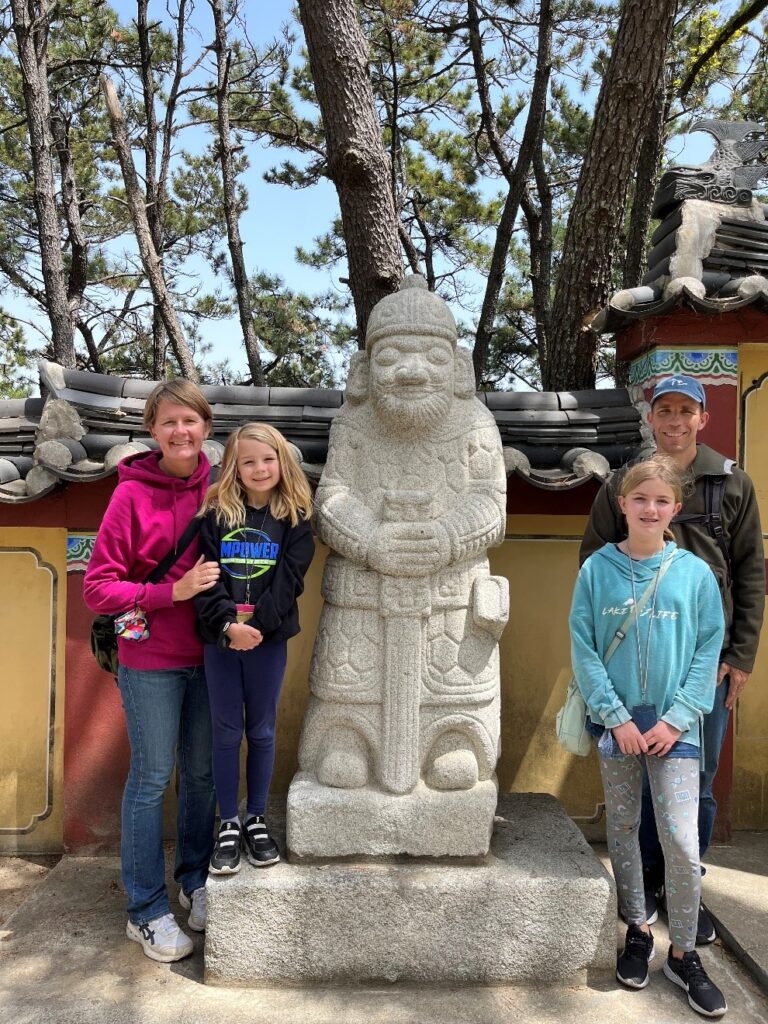
On Christmas Day, Prof. Frey and her family traveled to Suwon, South Korea where they settled in to live for six months. Her husband, Phil, continued working as a computer programmer for scientists at NIAID (National Institute of Allergy and Infectious Diseases) and fully enjoyed the array of Korean food while her daughters, Ellie and Matilda, attended the Korea International School and loved trips to Thailand, Japan, and Vietnam. While in Korea, Prof. Frey was a visiting faculty in the TNRC (Translational Nanobioscience Research Center) at SKKU (Sungkyunkwan University) in the lab of Prof. Josh Jackman where she was fortunate to work on several different research projects including finding eco-friendly detergent replacements for TX-100 to be used in bio-manufacturing processes, testing the functional mechanism of anti-cancer peptides, and looking at the interfacial characterization of novel sponge-phase lipid nanoparticles with applications in agriculture and drug delivery. Additionally, she gained experience with several new interfacial techniques, QCM-D (quartz crystal microbalance with dissipation monitoring) which can help analyze the mechanism of surface-interaction phenomena and EIS (electrochemical impedance spectroscopy) to measure induced membrane permeability. All in all, it was an incredibly rejuvenating year filled with science and family adventures. Upon Prof. Frey’s return to Gettysburg, Andrea Brazyte (’24 Chem) and Vy Tran (’25 Chem and Bio) joined Lipid lab to work on understanding the mechanism of detergent-mediated membrane disruption
During her year-long research sabbatical, Prof. Frey took advantage of her extra scholarship time to travel to some far-flung places to present her research to a variety of audiences. In September 2022, she presented a poster titled “Interaction of the huntingtin N-terminal sequence with model cell membranes” at the Biomembrane Days Meeting in Berlin, Germany where she had a mini-reunion with the folks from her last research sabbatical at the MPIKG (or for those not keeping track of all the acronyms, Max Planck Institute of Colloids and Interfaces). In October 2022, Prof. Frey traveled with Prof. Thompson to San Juan, Puerto Rico to SERMACS (Southeastern Regional Meeting of the American Chemical Society) to present the same poster. During her six-month stint in South Korea, Prof. Frey gave an invited lecture, “Interactions of huntingtin peptide with model cell membranes” as part of the International Workshop for Lipid Technology Innovation hosted by the Translational Nanobioscience Research Center at SKKU (Sungkyunkwan University) in Suwon. Upon her return to Gettysburg, Prof. Frey was invited to give a talk as part of the Gettysburg College BMB (Biochemistry and Molecular Biology) Seminar Series entitled “Proteins & Detergents & Nanoparticles – oh my! Research Sabbatical Adventures in Membrane Biophysics.”
Professor Kurt Andresen, Physics
Kurt Andresen published a paper in Proceedings of the National Academies of Science Nexus. The paper, entitled, “Effective cell membrane tension is independent of polyacrylamide substrate stiffness“ is based on research he performed during his sabbatical in Cambridge, England. Dr. Andresen’s students Sophia Dubois-Toscana (’25 Chem), Aisha Bah (’25 Phys), and Tam Nguyen (’24 Phys), presented three posters on work studying DNA condensation at the 2023 Biophysical Society meeting that included as co-authors Dr. Buettner and Dr. Frey.
Professor Jenn Powell, Biology
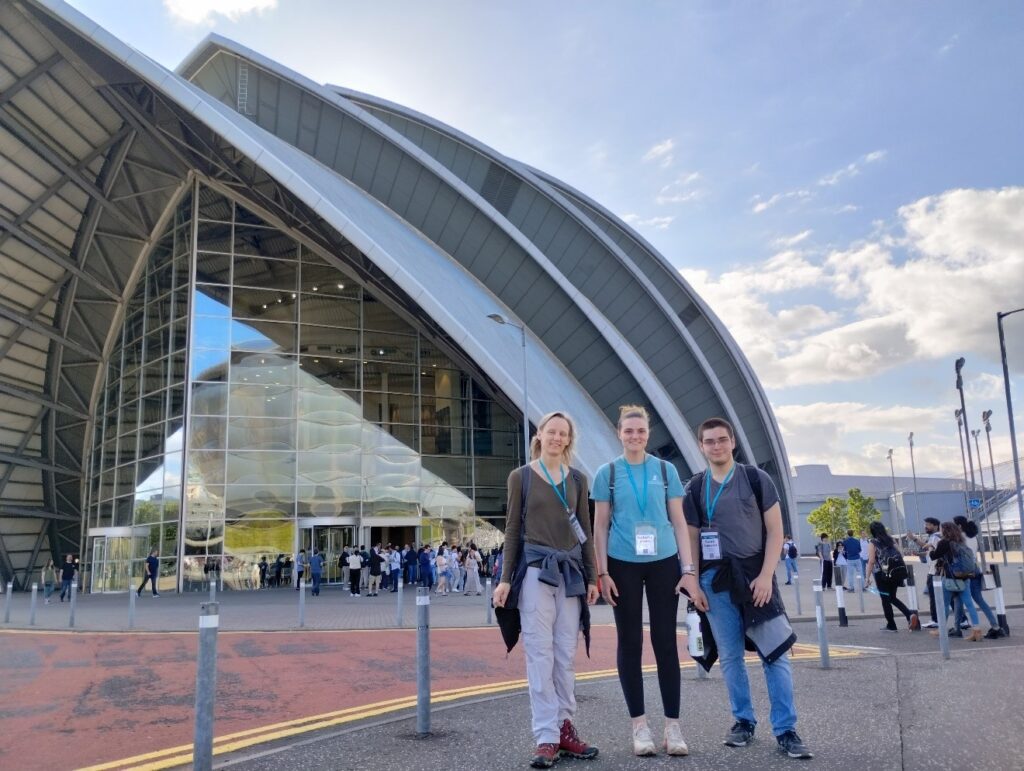
Jennifer Powell traveled with students Isabella Jensen (’24 BMB) and Noah Salewski (’25 BMB) to Glasgow, Scotland during the summer. They toured several excellent museums, attended a Scottish ceilidh, and voted for their favorite entries in the Worm Art Show. Most importantly, they presented their research projects at the International C. elegans meeting and saw many other fantastic talks and posters on the latest worm research from around the world.
For more about the Powell Lab’s trip to Scotland, including additional photos, see Noah’s entry in the X-SIG summer research blog.
Professor Ryan Kerney, Biology
The Kerney lab has been busy. We produced several papers since the last newsletter. These have appeared n Methods in Molecular Biology (with Elli Vickers ’20), Science Advances (with Zack Lewis, James Hanken), and Trends in Biotechnology (with Matt Cherubino ’22, Zoe Bender ’22). In the Fall 2022 semester Ryan Kerney took 18 Gettysburg Students to England for their Seminar: “The Revolution in Evolution.” Together they followed Darwin’s footsteps through the United Kingdom and visited multiple museums, archives, and universities that were instrumental in the history of evolutionary thought. Kerney also worked at HHMI’s Advanced Imaging Center during a sabbatical in the Spring of 2023 and has been analyzing the data with Ally Pancarella (’25). They intend to return for a second round of imaging projects in the summer of 2024.
Professor Véronique Delesalle
Véronique Delesalle and her lab are still happily focused on the evolutionary dynamics between bacteriophage viruses and their bacterial hosts. Over the last couple of years, we have published five manuscripts describing novel bacteriophages discovered by Gettysburg students and involving comparative analyses of their genomes. These publications involve 12 past and current Gettysbugrg students with Albert Vill (’16), Rachel Loney (’20) and Leigh Magness (’22) as lead authors:
Magness L.H., V.A. Delesalle, A.C. Vill, M.S. Strine, B.E. (Tomko)Chaudhry, K.B. (Boas)Lichty, A.A. (Agesen)Guffey, J.M. DeCurzio, and G.P. Krukonis. 2023. Bacillus subtilis phages related to SIOphi from desert soils of the Southwest United States. Accepted to PHAGE Dec 6th, 2023 – PHAGE-2023-0021
Vill, A.C., V.A. Delesalle, L.H. Magness, B. E. (Tomko)Chaudhry, K.B. (Boas)Lichty , M.S. Strine , A.A. Guffey, J.M. DeCurzio, G.P. Krukonis. Comparative genomics of Bacillus subtilis phages related to phiNIT1 from desert soils of the Southwest United States. 2023. Accepted to PHAGE Dec 6th, 2023 – PHAGE-2023-0027
Loney, R., V.A. Delesalle, B.E. Chaudry, M. Czerpak, A.A. Guffey, L. McCall-Goubet,, M. McCarty M.S. Strine, N.T. Tanke, A.C. Vill, and G.P. Krukonis. 2023. A novel subcluster of closely related Bacillus phages with distinct tail fiber/lysin gene combinations
. Viruses 2023, 15, 2267. https://doi.org/10.3390/v15112267
Delesalle V.A., B.E. Tomko, Albert C. Vill, Katherine Boas, and Greg P. Krukonis. 2022. Forty years without family: Three novel bacteriophages with high similarity to SPP1 reveal decades of evolutionary stasis since the isolation of their famous relative. Viruses 2022 Sep 23;14(10):2106. doi: 10.3390/v14102106. PMID: 36298661; PMCID: PMC9607348.
Vill, A.C., V.A. Delesalle, B.E. Tomko, K.B. Lichty, M.S. Strine, A.A. Guffey, E.A. Burton, N.T. Tanke and G.P. Krukonis. 2022. Comparative genomics of six lytic Bacillus subtilis phages from the Southwest United States. PHAGE Sep 2022.171-178. http://doi.org/10.1089/phage.2022.0030
Professor Matt Kittelberger, Biology
Matt Kittelberger published two papers recently. The first, entitled “Ca2+ entry units in a superfast fish muscle” in the journal Frontiers in Physiology describes the presence of a novel plastic structure in the vocal muscles in midshipman fish, proposed to underlie a calcium recycling pathway to help enable the sustained rapid muscle contractions necessary for vocal courtship calls in these fish. These so-called “Calcium-Entry Units” are upregulated during calling, are rapidly disassembled after calling ceases, and appear to be conserved across vertebrates. The second, entitled “Dopamine injections to the midbrain periaqueductal gray inhibit vocal-motor production in a teleost fish,” in the journal Physiology and Behavior, represents the culmination of a long-standing project begun by Alex Allen (’11) and Liz Heisler (’12) over 10 years ago! Both Alex and Liz (currently in the Neurology Dept. at NYU, and the Neurosurgery Dept. at the Univ. of Pennsylvania, respectively) were co-authors on the paper.
Professor Steve James, Biology
The James lab, aka the Fun-gal / Fun-guy Lab, finished a 6-year project that was published in GENETICS in October 2022 with 11 student coauthors . In this paper, we describe the discovery of an unusual reciprocal translocation, in which broken chromosomes swapped arms. Why unusual? Because the translocation simultaneously disrupted two genes unrelated to one another, yet both of them act separately (and together) to reverse the same cell cycle defect – now THAT is serendipity! Dr. James was invited to present this work in a plenary session of Asperfest 18 – the 18th international Aspergillus meeting, in March 2022.
Our research focus shifted when students in the Molecular Genetics course deleted a gene of unknown function and we subsequently discovered that this gene governs the stability of the microtubule cytoskeleton. When the gene, which we named wdA, is mutated, microtubules become unstable at low temperatures and cells undergo lethal mitotic catastrophe. We would love to know how this novel gene acts to maintain microtubule stability, as it is found in nearly all fungi, and is new to science. To that end, in 2022, Olivia Morren (’22), Ashley Gaffey (’22), Brandon Caban (’23), Lauren Cooke (’23), Allison Walsh (’23), and Kyle Miller (’24) used a variety of approaches, including western blotting, fluorescence microscopy, genetic analysis and gene and genome sequencing to interrogate the effects on microtubule stability of the wdA mutation and recently discovered mutations that modify the wdA mutant phenotype.
Dr. James spent spring and summer 2023 on sabbatical at The Sainsbury Laboratory in Norwich UK, where he studied the wdA gene in the economically important rice blast pathogen, Magnaporthe oryzae. M. oryzae is a devastating fungal pathogen – infections reduce worldwide rice yields by one-third annually. Working in the laboratory of Dr. Nick Talbot, Dr. James used co-immunoprecipitation + mass spectrometry (co-IP+MS) to discover the ‘interactome’ of the wdA protein – i.e., the proteins that associate physically with wdA. The James lab is currently sifting through a list of almost 1000 different candidate proteins (!) to ascertain which may be the bona fide interactors. He and wife Laura loved living in Norwich, and enjoyed British culture with trips around County Norfolk, excursions to London, Cornwall, and Edinburgh, and a memorable hiking tour of northern Scotland.
The lab has grown since return from sabbatical! Kyle Miller (’24) is completing BIO 460 this spring, and Krissy Heliodoro (’24), Sarah Neczesny (’25), Jonathan Zhuang (’24), Alessandro Zuccaroli (’25), Merlin Phan (’25), Mark Vo (’25), and Olivia Blusiewicz (’25) are working on gene tagging projects to add Green or Red Fluorescent Proteins to several candidate wdA interactors, after which they will carry out co-IP + western blotting to test for physical association of the proteins. We are getting closer to discovering the molecular basis of microtubule stabilization by wdA!
